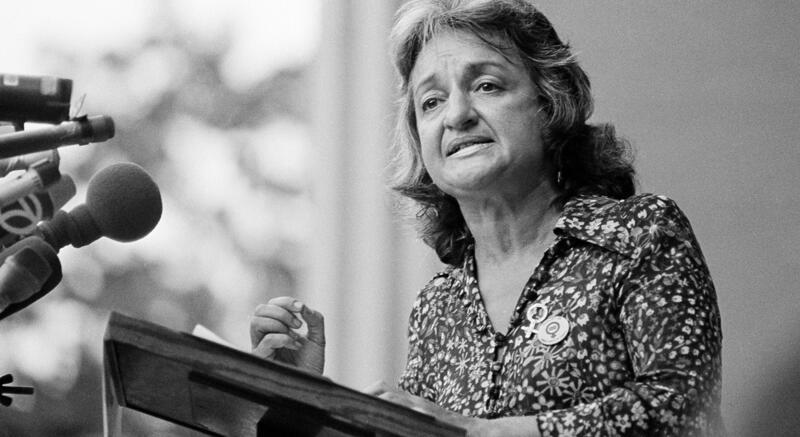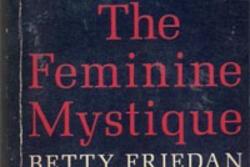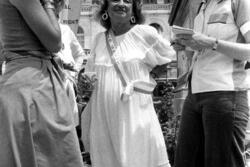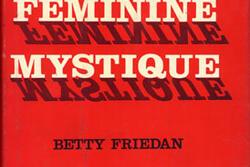Reading 'The Feminine Mystique' in 2021
How does one read a book like The Feminine Mystique (1963) in 2021? For a historian of work and motherhood in the United States like me, there is scarcely a more influential text. Written by Betty Friedan (née Bettye Goldstein), born 100 years ago today, The Feminine Mystique is a groundbreaking critique of 1950s womanhood. The book radically changed the mainstream conversation about the role of women, particularly married mothers, in the professional world. But we can’t understand it, or its impact, without grasping the contradictions of the America in which it was created and Friedan’s own shortcomings with race, sexuality, and class.
Historical Context
The late 1950s and early 1960s, when Friedan was researching and writing The Feminine Mystique, were a time of superficial stasis and underlying change in American women’s roles. Although working class mothers, disproportionately women of color, had always found ways to earn money for their families, middle and upper class women had traditionally not worked for pay during the first half of the century. That began to change during World War II when the shortage of men created openings in traditionally male fields, and suddenly middle class mothers who chose to work outside the home were billed as “patriotic,” rather than “unnatural.”
Though the majority lost those jobs with the end of the war, mothers’ workforce participation rates dipped only slightly in the late 1940s and soon began to climb. Even as the birth rate boomed and the breadwinner/homemaker family structure was celebrated throughout popular culture, the rates of maternal employment ticked upward throughout the 1950s. Pushed by the need for extra money in a consumer culture and pulled by a ballooning demand for workers in pink collar jobs, married women with children increasingly worked outside the home. At the same time, resistance to women in higher-status, higher-paid professions was unyielding. Against this backdrop, peppy articles about fitting in work around child rearing and housekeeping popped up in women’s magazines, alongside warnings by psychiatrists about the damage done to children by unavailable or unfeminine mothers.
The Feminine Mystique
The Feminine Mystique sold nearly three million copies in its first three years and made Betty Friedan a household name. What made the book so compelling? Friedan was hardly the first American commentator to write about the contradictions experienced by highly educated, financially comfortable American mothers. But she was the first since the 1930s—and certainly the most prominent—to do so through an uncompromisingly feminist framework. She cut through paeans to motherhood without apology. Unrelenting domesticity, she argued, “was burying millions of women alive.” Not only did it stifle their own intellect and creative capacity, it caused them to metaphorically smother their children, leading to “a kind of infantilism that makes the children...incapable of the effort, the endurance of pain and frustration, the discipline to compete.” (Contemporary readers of child rearing advice may find this early depiction of “helicopter parenting” startlingly familiar.) The only solution to this crisis, she argued, was fulfilling, paid, work.
The Response
This claim was electrifying. Thousands of letters poured in from women thanking her for finally naming and legitimizing their despair. Buoyed by her success and frustrated by the refusal of the federal government to enforce existing antidiscrimination laws, she joined together with civil rights activist and lawyer Pauli Murray, among others, to found the National Organization for Women (NOW).
Yet even as Friedan’s work galvanized an emerging women’s movement, her book drew sharp critiques from fellow feminists and other activists. Two in particular stood out: The first was that Friedan’s supposedly universal claims about American womanhood were drawn exclusively from suburban white women. She ignored the fact that working class women, and especially women of color, were far less likely to have the privilege to be stay at home mothers, instead being forced to take low-paying work while their children were cared for by others. Moreover, she failed to note that Black, Latina, Asian-American, and Native American women faced steeper barriers to professional careers than white women. The tension between claims of universally shared experiences of womanhood and the very different forms of oppression experienced by women with different identities has shaped the evolution of feminism from the outset.
The second critique, which dovetailed with the first, took aim at her insistence that paid work, and only paid work, could lead to psychological fulfillment. That claim not only ignored the satisfaction some women took from their domestic roles; it was laughable to many workers whose jobs were boring, low paid, and without the intellectual challenges she ascribed to paid work. Many women were only too happy to care for their children, homes, and communities, especially if the alternative was to scrub toilets, ring up groceries, or take dictation.
As historian Daniel Horowitz uncovered, Friedan knew well that Black women were egregiously discriminated against and that working class jobs could be exploitative, especially for women. She had worked in the 1940s as a journalist for the left-wing labor union United Electrical (UE), writing about the discrimination faced by women and minorities. But as McCarthyism took hold in the United States, she saw friends and colleagues blacklisted and smeared. Those memories were only a few years old when she carefully crafted The Feminine Mystique to avoid racial conflict, class critiques, and anything else that might have given critics an excuse to cry “Communist.”
Working Mothers in 2021
Given the glaring inadequacies of The Feminine Mystique, is there anything to be learned from it today? In a moment when women’s workforce participation—particularly among Black and Latina women—has been devastated by our national policy of treating women as our safety net, experts warn that the impact on women’s earnings, seniority, and status in the workplace could be severe and long-lasting. Betty Friedan recognized precisely how damaging it was for a nation to treat women as if their highest calling could only be the unpaid care of their family members. Being forced into roles that didn’t fit, deprived of the chance to earn their own money, and expected to sublimate their identities harmed women, and by saying so clearly, without qualifier or apology, she helped make it possible for other women to go further. When NOW demanded paid maternity leave, universal public childcare, and equal employment, they were building on the political scaffolding she constructed.
Perhaps more fundamentally, Friedan was not afraid to assert that women’s needs mattered. At the heart of her book was the belief that women need and deserve more than self-sacrifice at the altar of the family. This remains, even today, a radical claim.








One thing the article (and Friedan apparently) did not mention is that many men did not want their wives to work, not only because they wanted dinner on time, but because they felt it showed they were not earning enough if their wives "had" to work. So it was a status symbol for a man if his wife did not work.
Your "historical context" misses the most visible woman of 1963--Jacqueline Kennedy. With a limited number of national media outlets that all whitewashed the Kennedy story, she was presented as the ideal woman. Soft spoken (she sounded like Marilyn Monroe), thin, young and 2 cute kids. Never spoke out of turn. Years later we found out that she knew before she got married that the Kennedy men all had extramarital affairs and had accepted that her husband would do the same. Her father-in-law gave her big bucks to stay married and to buy the fashionable clothes for which she was admired. Her life was a PR lie. I was a preteen living in Canton, Ohio, when the book was published in 1963, and yes, at the time it was revolutionary to me.
Born in 1947 to a married 19 year old CCNY sophomore who was encouraged to leave school when she became a mother, I read Friedan's book when I was 16 years old and included it in the curriculum of Women's Studies class that I taught at Simmons College in the late 1970's and early 1980's. The book was pivotal to my understanding of the impact of "social pressure" on women's lives and I never relinquished my respect for it, even during Betty's long trial in the movement and the fervent critique that so many women had because she didn't account for all American women.